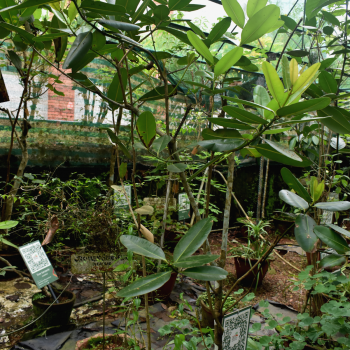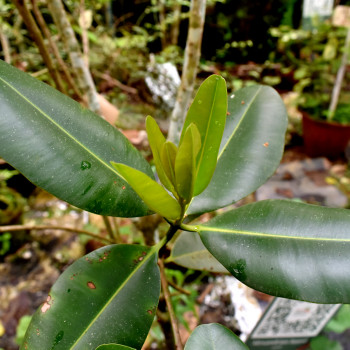Alexandrian laurel

Scientific Name :
Calophyllum inophyllum L.
Synonym(s) :
Calophyllum bintagor Roxb.
Local/Common name(s) :
Punna, Alexandrian laurel
Family :
Clusiaceae
Habit :
Tree
Flowering/Fruiting Time :
December-January
Habitat :
In plains along the banks of rivers and mangrove forests, also planted in the parks and roadsides
Endemic :
No
Status (IUCN) :
Least concern (LC)
Distribution :
Paleotropics
Nativity :
Indigenous
Uses :
Medicine
Description (Morphology) :
Tree, to 20 m tall; bark smooth or with boat-shaped fissures, brown to pale grey; exudate milky or yellow; branchlets compressed, slightly flat or 4-angled, glabrous. Leaves broadly elliptic-oblong or obovate, cuneate to rounded at base, slightly recurved and margined, rounded, acute, slightly emarginate, retuse or sub-acute at apex, 6-15 x 3-10.5 cm, coriaceous, glabrous; midnerve channelled above; raised beneath; lateral nerves 4-20 pairs; petioles flat, 1-1.7 cm long, glabrous. Racemes axillary, 5-12 cm long, (5-)7-12 flowered. Flowers polygamous, 2-2.5 cm across, white, fragrant; bracts ovate, 3-4 mm long, caducous; pedicels 1-3 cm long, glabrous. Sepals 4, reflexed; outer pair ovate to suborbicular, concave, 5.5-6.5 x 4.5-6.5 mm, nerved; the inner subelliptic, 9-15 x 7.5-9.5 mm, petaloid, nerved. Petals usually 4, rarely 3 or 5, obovate to elliptic or oblong, reflexed, 9-12 x 5-9 mm, rarely glabrous, nerved. Stamens (175-) 210-360(-440); filaments 3.5-5.5 mm long, connate for 1.5 mm into 4-6 bundles, cream coloured; anthers rounded or retuse at apex, 0.7-2 mm long. Ovary globose-depressed, stipitate; style 4.5-6.5 mm long; stigmas peltate, 3-5 radiate, 0.7-2 mm across. Drupes globose to obovoid, short apiculate, smooth; stone subglobose, ca 2 cm across.



